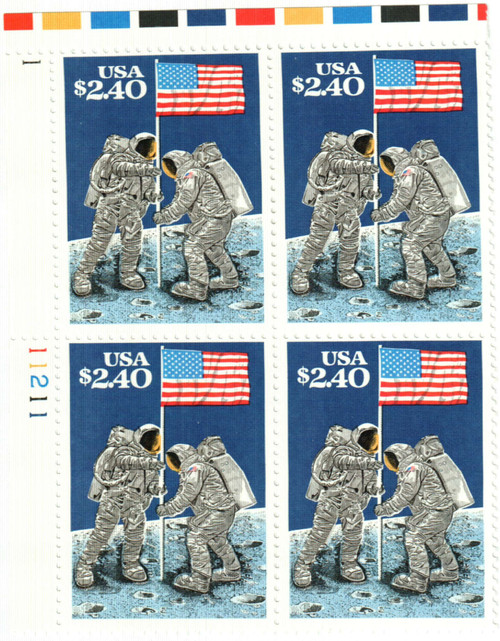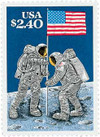
# 2419 - 1989 $2.40 Moon Landing
U.S. #2419
1989 $2.40 Moon Landing
- First US Priority Mail stamp
- Commemorates 20th anniversary of Moon Landing
- Art by Christopher Calle, whose father illustrated the 1969 Moon landing stamp
Stamp Category: Definitive, Priority Mail
Value: $2.40, Priority Mail rate (guarantees two- to three-day delivery)
First Day of Issue: July 20, 1989
First Day City: Washington, DC
Quantity Issued: 30,630,000
Printed by: Bureau of Engraving and Printing
Printing Method: Lithographed and engraved
Format: Panes of 20
Perforations: 11 x 11½
Why the stamp was issued: This was the first stamp issued to pay the Priority Mail rate. It covered the rate of $2.40 for items weighing between 12 ounces and two pounds. It guaranteed two-day delivery between major markets and three-day delivery elsewhere. The stamp was also valid for all categories of postage.
About the stamp design: Chris Calle was tasked with creating the artwork for this stamp, and he had a special connection to the 1969 Moon Landing stamp (US #C76). It was designed by his father, Paul Calle! When his father created the art for the 1969 stamp, he was doing so before the actual Moon landing. To help him create an accurate image, NASA gave him photos of the equipment and invited him to come and view some of it in person. He also got to watch Neil Armstrong practice his exit of the lunar module so he could accurately portray how he placed his foot on the ground.
When the time came for Chris to create his stamp, his father handed over his large file source materials to draw from. For his initial sketch, Calle illustrated one astronaut. But the USPS wanted to picture two. So, he adjusted his image. He had also included some text alluding to the 20th anniversary and the Moon landing, but the USPS wanted the image to be the main focus, so the only text left behind was the denomination and “USA.”
First Day City: The First Day ceremony for this stamp was held at the National Air and Space Museum in Washington, DC. It was the first time George Bush attended a stamp’s first day ceremony as president. All three Apollo 11 astronauts spoke at the ceremony.
Unusual fact about this stamp: Several errors are known to exist including black engraving omitted, black lithography omitted, imperforate, and tagging omitted. Some have also been found with a gray background (instead of blue) caused by a chemical wiping of the plate.
History the stamp represents: On July 20, 1969, the US effectively won the Space Race when Neil Armstrong and Buzz Aldrin landed the Eagle lunar module on the Moon’s surface.
The space race began 12 years earlier, on October 4, 1957, when the Soviet Union used rocket technology developed by the Germans in World War II to launch Sputnik, the world’s first artificial satellite. Originally, Sputnik was intended to be a massive, thousand-pound satellite. However, because the Americans were attempting to launch their own satellite, the decision was made to scale back the design considerably. At the time of launch, Sputnik was no bigger than a basketball.
Success continued for the Soviets during the next few years, prompting President John F. Kennedy to push NASA to place a man on the Moon before the end of the decade. Kennedy’s challenge was no small feat. At the time, the US space program wasn’t prepared for such an undertaking. There were no rockets, spacesuits, or computers capable of the task. NASA scientists didn’t know what they’d need to accomplish the goal, but they stepped up to the challenge. Hundreds of thousands of scientists and engineers joined together to achieve something many thought was impossible.
After thousands of hours of work over eight years, NASA launched Apollo 11 on July 16, 1969. Four days later, on July 20, 1969, their Eagle lunar module approached the Moon. The landing module touched down in a place called “West Crater,” which was scattered with boulders. After the landing, Aldrin requested everyone “…to pause for a moment and contemplate the events of the past few hours and to give thanks in his or her own way.”
Aldrin, who was an elder in his church, then proceeded to receive Communion from a kit prepared for him by his pastor. This was blacked out of the broadcast due to an ongoing lawsuit filed against NASA concerning the crew of the Apollo 8 mission reading from the Book of Genesis.
After the landing was completed, the crew began preparations for the Moonwalk. They had originally planned a five-hour sleep period, but it was decided they would be too excited to sleep.
Then, at 10:56 p.m. EDT, Armstrong set his left foot down upon the surface of the Moon and called it, “…one small step for a man, one giant leap for mankind.” Fellow astronaut Buzz Aldrin joined Armstrong on the surface and described the scene as “magnificent desolation.” Back on Earth, the world watched through a live television feed.
The Moonwalk wasn’t just symbolic – Armstrong and Aldrin had several tasks to perform. One of them included planting the American flag. They first had to get used to walking around on the Moon. They took photographs, collected rock, and dust samples and set out equipment to transmit readings. After about two-and-a-half hours, they returned to the landing module. When taking off their spacesuits they noticed a strange smell in the air. Armstrong described it as wet ashes and Aldrin said it was like “the smell in the air after a firecracker has gone off.” It was the smell of the Moon dust. Scientists had been concerned that the dust might ignite when it came in contact with oxygen when the module re-pressurized, but luckily, that wasn’t the case. Armstrong and Aldrin then took a much-deserved rest.
But this was the era of the Space Race, and the Soviet Union had launched an unmanned spacecraft three days before the Apollo 11 mission took off. As the US astronauts slept, Luna 15 began its descent to the Moon’s surface. It was the third attempt by the Soviets to collect lunar soil, and the third failure. Luna 15 crashed into the Moon, likely on the side of a mountain.
Following their rest, Armstrong and Aldrin blasted off from the Moon’s surface – unfortunately toppling the American flag they had planted. In future lunar landings, the flag was placed no closer than 100 feet from the modules, so as not to repeat that mistake.
The Eagle docked with the Columbia, where fellow astronaut Michael Collins had been waiting. The Eagle was released into orbit around the Moon, and NASA scientists later assumed that it crashed to the surface after a few months.
The Columbia command module, a 10-foot-long cone, was all that remained of the massive Saturn V rocket that began the journey. The Saturn V was 363 feet long and weighed 6,699,000 pounds (Columbia weighed 13,000 pounds). The journey home lasted three days, and the crew had to make only one correction.
On July 24, the command module separated and began its descent to Earth. The bottom of the module faced the surface and had special heat shields that would burn away during re-entry, to prevent the build-up of heat. The parachute opened after 195 hours and 13 minutes in space. The Apollo 11 crew splashed down in the Pacific Ocean, where Navy ship USS Hornet was nearby. They were finally home and President Kennedy’s vision was realized. America had effectively won the Space Race and was ready to embark on a new era in space exploration.
The three Apollo 11 astronauts were honored with a ticker-tape parade in New York City soon after returning to Earth. Armstrong received the Medal of Freedom, the highest award offered to a US civilian. His other awards included the NASA Distinguished Service Medal, the NASA Exceptional Service Medal, seventeen medals from other countries, and the Congressional Space Medal of Honor.
U.S. #2419
1989 $2.40 Moon Landing
- First US Priority Mail stamp
- Commemorates 20th anniversary of Moon Landing
- Art by Christopher Calle, whose father illustrated the 1969 Moon landing stamp
Stamp Category: Definitive, Priority Mail
Value: $2.40, Priority Mail rate (guarantees two- to three-day delivery)
First Day of Issue: July 20, 1989
First Day City: Washington, DC
Quantity Issued: 30,630,000
Printed by: Bureau of Engraving and Printing
Printing Method: Lithographed and engraved
Format: Panes of 20
Perforations: 11 x 11½
Why the stamp was issued: This was the first stamp issued to pay the Priority Mail rate. It covered the rate of $2.40 for items weighing between 12 ounces and two pounds. It guaranteed two-day delivery between major markets and three-day delivery elsewhere. The stamp was also valid for all categories of postage.
About the stamp design: Chris Calle was tasked with creating the artwork for this stamp, and he had a special connection to the 1969 Moon Landing stamp (US #C76). It was designed by his father, Paul Calle! When his father created the art for the 1969 stamp, he was doing so before the actual Moon landing. To help him create an accurate image, NASA gave him photos of the equipment and invited him to come and view some of it in person. He also got to watch Neil Armstrong practice his exit of the lunar module so he could accurately portray how he placed his foot on the ground.
When the time came for Chris to create his stamp, his father handed over his large file source materials to draw from. For his initial sketch, Calle illustrated one astronaut. But the USPS wanted to picture two. So, he adjusted his image. He had also included some text alluding to the 20th anniversary and the Moon landing, but the USPS wanted the image to be the main focus, so the only text left behind was the denomination and “USA.”
First Day City: The First Day ceremony for this stamp was held at the National Air and Space Museum in Washington, DC. It was the first time George Bush attended a stamp’s first day ceremony as president. All three Apollo 11 astronauts spoke at the ceremony.
Unusual fact about this stamp: Several errors are known to exist including black engraving omitted, black lithography omitted, imperforate, and tagging omitted. Some have also been found with a gray background (instead of blue) caused by a chemical wiping of the plate.
History the stamp represents: On July 20, 1969, the US effectively won the Space Race when Neil Armstrong and Buzz Aldrin landed the Eagle lunar module on the Moon’s surface.
The space race began 12 years earlier, on October 4, 1957, when the Soviet Union used rocket technology developed by the Germans in World War II to launch Sputnik, the world’s first artificial satellite. Originally, Sputnik was intended to be a massive, thousand-pound satellite. However, because the Americans were attempting to launch their own satellite, the decision was made to scale back the design considerably. At the time of launch, Sputnik was no bigger than a basketball.
Success continued for the Soviets during the next few years, prompting President John F. Kennedy to push NASA to place a man on the Moon before the end of the decade. Kennedy’s challenge was no small feat. At the time, the US space program wasn’t prepared for such an undertaking. There were no rockets, spacesuits, or computers capable of the task. NASA scientists didn’t know what they’d need to accomplish the goal, but they stepped up to the challenge. Hundreds of thousands of scientists and engineers joined together to achieve something many thought was impossible.
After thousands of hours of work over eight years, NASA launched Apollo 11 on July 16, 1969. Four days later, on July 20, 1969, their Eagle lunar module approached the Moon. The landing module touched down in a place called “West Crater,” which was scattered with boulders. After the landing, Aldrin requested everyone “…to pause for a moment and contemplate the events of the past few hours and to give thanks in his or her own way.”
Aldrin, who was an elder in his church, then proceeded to receive Communion from a kit prepared for him by his pastor. This was blacked out of the broadcast due to an ongoing lawsuit filed against NASA concerning the crew of the Apollo 8 mission reading from the Book of Genesis.
After the landing was completed, the crew began preparations for the Moonwalk. They had originally planned a five-hour sleep period, but it was decided they would be too excited to sleep.
Then, at 10:56 p.m. EDT, Armstrong set his left foot down upon the surface of the Moon and called it, “…one small step for a man, one giant leap for mankind.” Fellow astronaut Buzz Aldrin joined Armstrong on the surface and described the scene as “magnificent desolation.” Back on Earth, the world watched through a live television feed.
The Moonwalk wasn’t just symbolic – Armstrong and Aldrin had several tasks to perform. One of them included planting the American flag. They first had to get used to walking around on the Moon. They took photographs, collected rock, and dust samples and set out equipment to transmit readings. After about two-and-a-half hours, they returned to the landing module. When taking off their spacesuits they noticed a strange smell in the air. Armstrong described it as wet ashes and Aldrin said it was like “the smell in the air after a firecracker has gone off.” It was the smell of the Moon dust. Scientists had been concerned that the dust might ignite when it came in contact with oxygen when the module re-pressurized, but luckily, that wasn’t the case. Armstrong and Aldrin then took a much-deserved rest.
But this was the era of the Space Race, and the Soviet Union had launched an unmanned spacecraft three days before the Apollo 11 mission took off. As the US astronauts slept, Luna 15 began its descent to the Moon’s surface. It was the third attempt by the Soviets to collect lunar soil, and the third failure. Luna 15 crashed into the Moon, likely on the side of a mountain.
Following their rest, Armstrong and Aldrin blasted off from the Moon’s surface – unfortunately toppling the American flag they had planted. In future lunar landings, the flag was placed no closer than 100 feet from the modules, so as not to repeat that mistake.
The Eagle docked with the Columbia, where fellow astronaut Michael Collins had been waiting. The Eagle was released into orbit around the Moon, and NASA scientists later assumed that it crashed to the surface after a few months.
The Columbia command module, a 10-foot-long cone, was all that remained of the massive Saturn V rocket that began the journey. The Saturn V was 363 feet long and weighed 6,699,000 pounds (Columbia weighed 13,000 pounds). The journey home lasted three days, and the crew had to make only one correction.
On July 24, the command module separated and began its descent to Earth. The bottom of the module faced the surface and had special heat shields that would burn away during re-entry, to prevent the build-up of heat. The parachute opened after 195 hours and 13 minutes in space. The Apollo 11 crew splashed down in the Pacific Ocean, where Navy ship USS Hornet was nearby. They were finally home and President Kennedy’s vision was realized. America had effectively won the Space Race and was ready to embark on a new era in space exploration.
The three Apollo 11 astronauts were honored with a ticker-tape parade in New York City soon after returning to Earth. Armstrong received the Medal of Freedom, the highest award offered to a US civilian. His other awards included the NASA Distinguished Service Medal, the NASA Exceptional Service Medal, seventeen medals from other countries, and the Congressional Space Medal of Honor.















